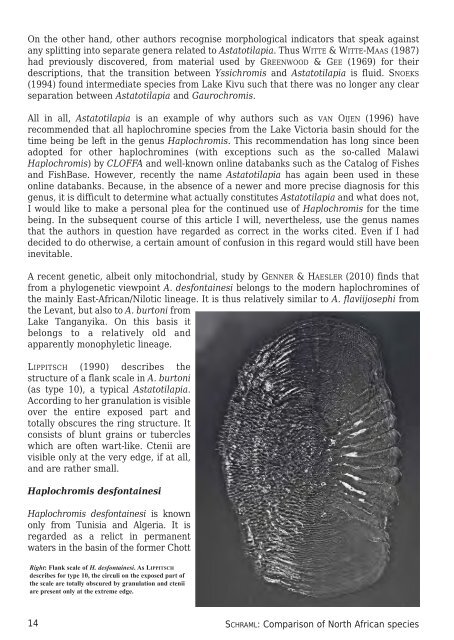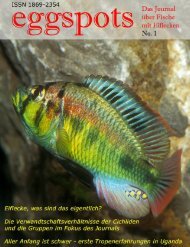Eggspots Elsewhere - Welt der Fische / World of Fishes
Eggspots Elsewhere - Welt der Fische / World of Fishes
Eggspots Elsewhere - Welt der Fische / World of Fishes
You also want an ePaper? Increase the reach of your titles
YUMPU automatically turns print PDFs into web optimized ePapers that Google loves.
On the other hand, other authors recognise morphological indicators that speak against<br />
any splitting into separate genera related to Astatotilapia. Thus WITTE & WITTE-MAAS (1987)<br />
had previously discovered, from material used by GREENWOOD & GEE (1969) for their<br />
descriptions, that the transition between Yssichromis and Astatotilapia is fluid. SNOEKS<br />
(1994) found intermediate species from Lake Kivu such that there was no longer any clear<br />
separation between Astatotilapia and Gaurochromis.<br />
All in all, Astatotilapia is an example <strong>of</strong> why authors such as VAN OIJEN (1996) have<br />
recommended that all haplochromine species from the Lake Victoria basin should for the<br />
time being be left in the genus Haplochromis. This recommendation has long since been<br />
adopted for other haplochromines (with exceptions such as the so-called Malawi<br />
Haplochromis) by CLOFFA and well-known online databanks such as the Catalog <strong>of</strong> <strong>Fishes</strong><br />
and FishBase. However, recently the name Astatotilapia has again been used in these<br />
online databanks. Because, in the absence <strong>of</strong> a newer and more precise diagnosis for this<br />
genus, it is difficult to determine what actually constitutes Astatotilapia and what does not,<br />
I would like to make a personal plea for the continued use <strong>of</strong> Haplochromis for the time<br />
being. In the subsequent course <strong>of</strong> this article I will, nevertheless, use the genus names<br />
that the authors in question have regarded as correct in the works cited. Even if I had<br />
decided to do otherwise, a certain amount <strong>of</strong> confusion in this regard would still have been<br />
inevitable.<br />
A recent genetic, albeit only mitochondrial, study by GENNER & HAESLER (2010) finds that<br />
from a phylogenetic viewpoint A. desfontainesi belongs to the mo<strong>der</strong>n haplochromines <strong>of</strong><br />
the mainly East-African/Nilotic lineage. It is thus relatively similar to A. flaviijosephi from<br />
the Levant, but also to A. burtoni from<br />
Lake Tanganyika. On this basis it<br />
belongs to a relatively old and<br />
apparently monophyletic lineage.<br />
LIPPITSCH (1990) describes the<br />
structure <strong>of</strong> a flank scale in A. burtoni<br />
(as type 10), a typical Astatotilapia.<br />
According to her granulation is visible<br />
over the entire exposed part and<br />
totally obscures the ring structure. It<br />
consists <strong>of</strong> blunt grains or tubercles<br />
which are <strong>of</strong>ten wart-like. Ctenii are<br />
visible only at the very edge, if at all,<br />
and are rather small.<br />
Haplochromis desfontainesi<br />
Haplochromis desfontainesi is known<br />
only from Tunisia and Algeria. It is<br />
regarded as a relict in permanent<br />
waters in the basin <strong>of</strong> the former Chott<br />
Right: Flank scale <strong>of</strong> H. desfontainesi. As LIPPITSCH<br />
describes for type 10, the circuli on the exposed part <strong>of</strong><br />
the scale are totally obscured by granulation and ctenii<br />
are present only at the extreme edge.<br />
14<br />
SCHRAML: Comparison <strong>of</strong> North African species




